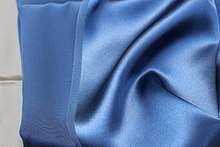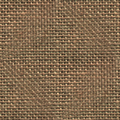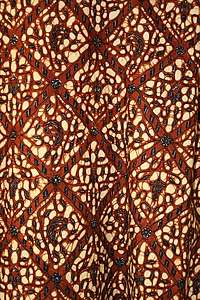Charmeuse
Charmeuse (French: [ʃaʁmøz]) is a lightweight fabric woven with a satin weave, in which the warp threads cross over four or more of the backing (weft) threads. These float threads give the front of the fabric a smooth, shiny finish, whereas the back has a dull finish. Charmeuse differs from plain satin in that charmeuse has a different ratio of float (face) threads. Charmeuse may be made of silk or polyester. It is used in women's clothing such as lingerie, evening gowns, and blouses, especially garments with a bias cut. It is occasionally used in menswear.

Characteristics
Charmeuse is lightweight and drapes easily.[1] It has a satin side, which is shiny, and a matte side, which is dull.[2][1]
It can be made of silk or a synthetic lookalike such as polyester. Silk charmeuse is more expensive and delicate but is softer and a better insulator.[3]
Polyester charmeuse is cheaper and can often withstand machine washing, but it does not breathe as well as silk. Polyester charmeuse has characteristics that are undesirable for sewing, including a tendency to pucker at the seams[4] and fraying during cutting and handling.[2] When woven from polyester it can be a challenging fabric to sew; it tends to be slippery and may be difficult to control through the presser foot of a sewing machine. Seams have a tendency to pucker and pull; a smaller stitch length and properly balanced tensions can minimize this, though the experience of the sewer will affect the finished result as well. Pins can make holes and marks in polyester charmeuse so it is very important to use proper, sharp dressmaker's pins with a smooth, not abrupt, taper to the point. For greater ease of sewing, a sizing product can be sprayed on before cutting and washed out after the garment is completed.
Uses
The luster and delicate hand make charmeuse suited to lingerie, flowing evening gowns, and draped blouses. Bridal gowns sometimes use charmeuse. Because the fabric does not hold a shape well and tends to cling and hang against the body, it is not used for full, flared skirts. It is best suited to a more fluid, slinky bias cut.
Its uses in menswear include the lining of jackets and slacks, handkerchiefs, ties, and underwear such as charmeuse boxer shorts.
The look of charmeuse is prized for dressy garments, especially when cut on the bias, a technique used to create garments that flow well on the body.
References
- "What Is Satin Fabric? A Guide to the Types, Characteristics, and Uses for Satin". Masterclass. 2 July 2019. Retrieved 9 July 2020.
- The Mood Guide to Fabric and Fashion: The Essential Guide from the World's Most Famous Fabric Store. ABRAMS. 2015. ISBN 9781613128725. Retrieved 9 July 2020.
- "Colored Satin Charmeuse". The Montreal Daily Mail. November 2, 1914.
- Betzina, Sandra (2004). More Fabric Savvy: A Quick Resource Guide to Selecting and Sewing Fabric. Taunton Press. pp. 28–29. ISBN 9781561586622. Retrieved 9 July 2020.


.svg.png)